Urban Metabolism of Food-Sourced Nitrogen among Different Income Households: A Case Study Based on Large Sample Survey in Xiamen City, China
Abstract
1. Introduction
2. Materials and Methods
2.1. Study Area and Survey Sites
2.2. Survey Design and Data Processing
2.3. Methods
2.3.1. Nitrogen Content in Household Food Consumption
2.3.2. Nitrogen Flow Path and Environmental Emissions Calculation
2.3.3. Impact Factor Analysis of Food-Sourced Environmental Nitrogen Emissions
3. Results
3.1. Household Food Consumption and Nitrogen Consumption
3.2. Environmental Nitrogen Emissions Due to Household Food Consumption
3.3. Key Factors Influencing Food-Sourced Environmental Nitrogen Emissions
4. Discussion
4.1. Characterizing Environmental Nitrogen Emissions from Urban Household Food Consumption
4.2. Policy Making toward Urban Food Security Consumption Patterns
4.3. Technologies Integration and Innovation toward Sustainable Nitrogen Cycling
5. Conclusions
Author Contributions
Funding
Informed Consent Statement
Data Availability Statement
Acknowledgments
Conflicts of Interest
Appendix A
| Items | Variables | Formulas |
|---|---|---|
| Food consumption | N in food waste | Per capita food-sourced nitrogen consumption × food waste ratio |
| Human digestion | N in human absorption | Per capita food-sourced nitrogen consumption × human food absorption ratio |
| N of human excreta | Per capita food-sourced nitrogen consumption × human excreta emission ratio | |
| Waste treatment | N in food waste treatment | N in food waste × percentage of garbage treatment with standard |
| N in human excreta treatment | N of human excreta × percentage of sewage treatment of city | |
| N volatilized from sewage treatment | N in human excreta treatment × N2O emission factor | |
| N in food waste compost | N in food waste treatment × composting ratio of food waste treatment | |
| N in food waste landfill | N in food waste treatment × landfill ratio of food waste treatment | |
| N in food waste incineration | N in food waste treatment × incineration ratio of food waste treatment | |
| N volatilized from food waste compost | N in food waste compost × fertilizer volatile ratio | |
| Environmental emissions | N in food waste direct discharge | N in food waste—N in food waste treatment |
| N in human excreta direct discharge | N of human excreta—N of human excreta sludge—N of human excreta tail water—N emissions from sewage treatment | |
| N of human excreta sludge | N in human excreta treatment × N removal ratio of human excreta | |
| N of human excreta tail water | N in human excreta treatment × (1-N removal ratio of human excreta) | |
| N emissions in soil | N in food waste direct discharge + N of human excreta sludge + N in food waste landfill | |
| N emissions in water | N in human excreta direct discharge + N of human excreta tail water | |
| N emissions in air | N emissions from sewage treatment + N volatilized from food waste compost + N in food waste incineration |
| Items | Parameters | Unit | Values | Source |
|---|---|---|---|---|
| Food consumption | N content in food waste | % | 40 | [3] |
| Human digestion | Human food absorption ratio | % | 2 | [79] |
| Human excreta emission ratio | % | 88 | [80] | |
| Waste treatment | Percentage of garbage treatment with standard | % | 98.32 | [81] |
| Percentage of sewage treatment of city | % | 90.40 | [81] | |
| N removal ratio of human excreta | % | 60 | [82] | |
| The composting ratio of food waste treatment | % | 2.6 | [83] | |
| The landfill ratio of food waste treatment | % | 61.4 | [83] | |
| The incineration ratio of food waste treatment | % | 15.9 | [83] | |
| Environmental emissions | N volatilized ratio from human excreta | % | 24.5 | [84] |
| N2O emission factor | kg N2O/kg N | 0.005 | [85] |
References
- Galloway, J.N.; Dentener, F.J.; Capone, D.G.; Boyer, E.W.; Howarth, R.W.; Seitzinger, S.P.; Asner, G.P.; Cleveland, C.C.; Green, P.A.; Holland, E.A.; et al. Nitrogen Cycles: Past, Present, and Future. Biogeochemistry 2004, 70, 153–226. [Google Scholar] [CrossRef]
- Liu, C.; Zou, C.; Wang, Q.; Hayashi, Y.; Yasunari, T. Impact assessment of human diet changes with rapid urbanization on regional nitrogen and phosphorus flows—A case study of the megacity Shanghai. Environ. Sci. Pollut. Res. 2013, 21, 1905–1914. [Google Scholar] [CrossRef]
- Lin, T.; Wang, J.; Bai, X.; Zhang, G.; Li, X.; Ge, R.; Ye, H. Quantifying and managing food-sourced nutrient metabolism in Chinese cities. Environ. Int. 2016, 94, 388–395. [Google Scholar] [CrossRef]
- Lin, T.; Gibson, V.; Cui, S.; Yu, C.-P.; Chen, S.; Ye, Z.; Zhu, Y.-G. Managing urban nutrient biogeochemistry for sustainable urbanization. Environ. Pollut. 2014, 192, 244–250. [Google Scholar] [CrossRef] [PubMed]
- Li, Y.; Cui, S.; Gao, B.; Tang, J.; Huang, W.; Huang, Y. Modeling nitrogen flow in a coastal city—A case study of Xiamen in 2015. Sci. Total Environ. 2020, 735, 139294. [Google Scholar] [CrossRef]
- Huang, W.; Gao, B.; Huang, Y.; Zhang, Z.; Xu, S.; Xu, L.; Cui, S. Transforming nitrogen management of the urban food system in a food-sink city. J. Environ. Manag. 2019, 249, 109180. [Google Scholar] [CrossRef]
- Fang, S.; Pang, H.; Dai, X. Soil nitrogen and phosphorous dynamics by in situ soil experiments along an urban-rural gradient in Shanghai, China. Environ. Sci. Pollut. Res. 2019, 26, 31026–31037. [Google Scholar] [CrossRef]
- Billen, G.; Barles, S.; Garnier, J.; Rouillard, J.; Benoit, P. The food-print of Paris: Long-term reconstruction of the nitrogen flows imported into the city from its rural hinterland. Reg. Environ. Chang. 2008, 9, 13–24. [Google Scholar] [CrossRef]
- Bernhardt, E.S.; Band, L.E.; Walsh, C.J.; Berke, P.E. Understanding, Managing, and Minimizing Urban Impacts on Surface Water Nitrogen Loading. Ann. N. Y. Acad. Sci. 2008, 1134, 61–96. [Google Scholar] [CrossRef]
- Zhang, Y.; Lu, H.; Fath, B.D.; Zheng, H. Modelling urban nitrogen metabolic processes based on ecological network analysis: A case of study in Beijing, China. Ecol. Model. 2016, 337, 29–38. [Google Scholar] [CrossRef]
- Pan, J.; Ding, N.; Yang, J. Changes of urban nitrogen metabolism in the Beijing megacity of China, 2000–2016. Sci. Total Environ. 2019, 666, 1048–1057. [Google Scholar] [CrossRef]
- Nigussie, A.; Bruun, S.; Kuyper, T.; de Neergaard, A. Delayed addition of nitrogen-rich substrates during composting of municipal waste: Effects on nitrogen loss, greenhouse gas emissions and compost stability. Chemosphere 2017, 166, 352–362. [Google Scholar] [CrossRef]
- Kim, S.; Dale, B.E. Effects of Nitrogen Fertilizer Application on Greenhouse Gas Emissions and Economics of Corn Production. Environ. Sci. Technol. 2008, 42, 6028–6033. [Google Scholar] [CrossRef]
- Xie, M.; Zhu, K.; Wang, T.; Chen, P.; Han, Y.; Li, S.; Zhuang, B.; Shu, L. Temporal characterization and regional contribution to O3 and NOx at an urban and a suburban site in Nanjing, China. Sci. Total Environ. 2016, 551–552, 533–545. [Google Scholar] [CrossRef] [PubMed]
- Vitousek, P.M.; Aber, J.D.; Howarth, R.W.; Likens, G.E.; Matson, P.A.; Schindler, D.W.; Schlesinger, W.H.; Tilman, D.G. Technical Report: Human Alteration of the Global Nitrogen Cycle: Sources and Consequences. Ecol. Appl. 1997, 7, 737–750. [Google Scholar] [CrossRef]
- Liu, X.; Zhang, Y.; Han, W.; Tang, A.; Shen, J.; Cui, Z.; Vitousek, P.; Erisman, J.W.; Goulding, K.; Christie, P.; et al. Enhanced nitrogen deposition over China. Nat. Cell Biol. 2013, 494, 459–462. [Google Scholar] [CrossRef]
- Deegan, L.A.; Johnson, D.; Warren, R.S.; Peterson, B.J.; Fleeger, J.W.; Fagherazzi, S.; Wollheim, W. Coastal eutrophication as a driver of salt marsh loss. Nature 2012, 490, 388–392. [Google Scholar] [CrossRef]
- Carpenter, S.R.; Caraco, N.F.; Correll, D.L.; Howarth, R.W.; Sharpley, A.N.; Smith, V.H. Nonpoint pollution of surface waters with phosphorus and nitrogen. Ecol. Appl. 1998, 8, 559–568. [Google Scholar] [CrossRef]
- Wu, H.; Du, S.; Zhang, Y.; An, J.; Zou, H.; Yu, N.; Zhang, Y. Effects of irrigation and nitrogen fertilization on greenhouse soil organic nitrogen fractions and soil-soluble nitrogen pools. Agric. Water Manag. 2019, 216, 415–424. [Google Scholar] [CrossRef]
- Wang, X.; Bai, J.; Xie, T.; Wang, W.; Zhang, G.; Yin, S.; Wang, D. Effects of biological nitrification inhibitors on nitrogen use efficiency and greenhouse gas emissions in agricultural soils: A review. Ecotoxicol. Environ. Saf. 2021, 220, 112338. [Google Scholar] [CrossRef] [PubMed]
- Tilman, D.; Lehman, C. Human-caused environmental change: Impacts on plant diversity and evolution. Proc. Natl. Acad. Sci. USA 2001, 98, 5433–5440. [Google Scholar] [CrossRef]
- Hooper, D.U.; Adair, E.C.; Cardinale, B.J.; Byrnes, J.; Hungate, A.B.; Matulich, K.L.; Gonzalez, A.; Duffy, J.E.; Gamfeldt, L.; O’Connor, M.I. A global synthesis reveals biodiversity loss as a major driver of ecosystem change. Nature 2012, 486, 105–108. [Google Scholar] [CrossRef] [PubMed]
- Bodirsky, B.L.; Popp, A.; Lotze-Campen, H.; Dietrich, J.P.; Rolinski, S.; Weindl, I.; Schmitz, C.; Müller, C.; Bonsch, M.; Humpenöder, F.; et al. Reactive nitrogen requirements to feed the world in 2050 and potential to mitigate nitrogen pollution. Nat. Commun. 2014, 5, 3858. [Google Scholar] [CrossRef] [PubMed]
- Socolow, R.H. Nitrogen management and the future of food: Lessons from the management of energy and carbon. Proc. Natl. Acad. Sci. USA 1999, 96, 6001–6008. [Google Scholar] [CrossRef] [PubMed]
- Barles, S. Feeding the city: Food consumption and flow of nitrogen, Paris, 1801–1914. Sci. Total Environ. 2007, 375, 48–58. [Google Scholar] [CrossRef]
- Gao, B.; Huang, W.; Wang, L.; Huang, Y.; Ding, S.; Cui, S. Driving forces of nitrogen flows and nitrogen use efficiency of food systems in seven Chinese cities, 1990 to 2015. Sci. Total Environ. 2019, 676, 144–154. [Google Scholar] [CrossRef] [PubMed]
- Huang, W.; Gao, B.; Lin, J.; Cui, S.; Zhong, Q.; Huang, C. Driving forces of nitrogen input into city-level food systems: Comparing a food-source with a food-sink prefecture-level city in China. Resour. Conserv. Recycl. 2020, 160, 104850. [Google Scholar] [CrossRef]
- Cease, A.J.; Capps, K.A.; Gates, K.K.; McCrackin, M.; Nidzgorski, D.A. Consumer-driven nutrient dynamics in urban environments: The stoichiometry of human diets and waste management. Oikos 2015, 124, 931–948. [Google Scholar] [CrossRef]
- Sammarchi, S.; Li, J.; Yang, Q. Dietary shifts and nitrogen losses to water in urban China: The case of Shanghai. Environ. Sci. Pollut. Res. 2020, 28, 40088–40102. [Google Scholar] [CrossRef]
- Fissore, C.; Baker, L.A.; Hobbie, S.E.; King, J.Y.; McFadden, J.P.; Nelson, K.C.; Jakobsdottir, I. Carbon, nitrogen, and phosphorus fluxes in household ecosystems in the Minneapolis-Saint Paul, Minnesota, urban region. Ecol. Appl. 2011, 21, 619–639. [Google Scholar] [CrossRef]
- Long, Y.; Hu, R.; Yin, T.; Wang, P.; Liu, J.; Muhammad, T.; Chen, X.; Li, Y. Spatial-Temporal Footprints Assessment and Driving Mechanism of China Household Diet Based on CHNS. Foods 2021, 10, 1858. [Google Scholar] [CrossRef]
- Chai, L.; Han, Z.; Liang, Y.; Su, Y.; Huang, G. Understanding the blue water footprint of households in China from a perspective of consumption expenditure. J. Clean. Prod. 2020, 262, 121321. [Google Scholar] [CrossRef]
- Han, Y.; Duan, H.; Du, X.; Jiang, L. Chinese household environmental footprint and its response to environmental awareness. Sci. Total Environ. 2021, 782, 146725. [Google Scholar] [CrossRef]
- Liao, X.; Chai, L.; Liang, Y. Income impacts on household consumption’s grey water footprint in China. Sci. Total Environ. 2020, 755, 142584. [Google Scholar] [CrossRef]
- Oita, A.; Malik, A.; Kanemoto, K.; Geschke, A.; Nishijima, A.O.S.; Lenzen, M. Substantial nitrogen pollution embedded in international trade. Nat. Geosci. 2016, 9, 111–115. [Google Scholar] [CrossRef]
- Cai, B.; Liu, B.; Zhang, B. Evolution of Chinese urban household’s water footprint. J. Clean. Prod. 2018, 208, 1–10. [Google Scholar] [CrossRef]
- Uwizeye, A.; De Boer, I.J.M.; Opio, C.I.; Schulte, R.P.O.; Falcucci, A.; Tempio, G.; Teillard, F.; Casu, F.; Rulli, M.; Galloway, J.N.; et al. Nitrogen emissions along global livestock supply chains. Nat. Food 2020, 1, 437–446. [Google Scholar] [CrossRef]
- Eshel, G.; Shepon, A.; Noor, E.; Milo, R. Environmentally Optimal, Nutritionally Aware Beef Replacement Plant-Based Diets. Environ. Sci. Technol. 2016, 50, 8164–8168. [Google Scholar] [CrossRef]
- Thaler, S.; Zessner, M.; Weigl, M.; Rechberger, H.; Schilling, K.; Kroiss, H. Possible implications of dietary changes on nutrient fluxes, environment and land use in Austria. Agric. Syst. 2015, 136, 14–29. [Google Scholar] [CrossRef]
- Klement, L.; Bach, M.; Geupel, M.; Breuer, L. Calculation of a food consumption nitrogen footprint for Germany. Environ. Res. Lett. 2021, 16, 075005. [Google Scholar] [CrossRef]
- Springmann, M.; Wiebe, K.; Mason-D’Croz, D.; Sulser, T.B.; Rayner, M.; Scarborough, P. Health and nutritional aspects of sustainable diet strategies and their association with environmental impacts: A global modelling analysis with country-level detail. Lancet Planet. Health 2018, 2, e451–e461. [Google Scholar] [CrossRef]
- Xue, X.; Landis, A.E. Eutrophication Potential of Food Consumption Patterns. Environ. Sci. Technol. 2010, 44, 6450–6456. [Google Scholar] [CrossRef]
- Müller, E.; Hilty, L.; Widmer, R.; Schluep, M.; Faulstich, M. Modeling Metal Stocks and Flows: A Review of Dynamic Material Flow Analysis Methods. Environ. Sci. Technol. 2014, 48, 2102–2113. [Google Scholar] [CrossRef]
- Liang, S.; Qu, S.; Zhao, Q.; Zhang, X.; Daigger, G.T.; Newell, J.P.; Miller, S.A.; Johnson, J.; Love, N.G.; Zhang, L.; et al. Quantifying the Urban Food–Energy–Water Nexus: The Case of the Detroit Metropolitan Area. Environ. Sci. Technol. 2018, 53, 779–788. [Google Scholar] [CrossRef]
- Lin, T.; Yu, Y.; Bai, X.; Feng, L.; Wang, J. Greenhouse Gas Emissions Accounting of Urban Residential Consumption: A Household Survey Based Approach. PLoS ONE 2013, 8, e55642. [Google Scholar] [CrossRef]
- Xiamen Bureau of Statistics; Xiamen Investigation Team, National Bureau of Statistics. Yearbook of Xiamen Special Economic Zone; China Statistics Press: Beijing, China, 2020.
- Wang, J.F.; Li, L.F.; Ge, Y.; Shi, P.Z.; Guan, Y.X.; Bai, Y.C.; Wang, Z.Y.; Robert, H. A Theoretic Framework for Spatial Analysis. Acta Geogr. Sin. 2000, 55, 92–103. [Google Scholar]
- Cao, X.; Li, X.H.; Gao, L.L.; Xing, L. Site selection of multi-objective survey. J. Geo-Inform. Sci. 2018, 20, 1381–1387. [Google Scholar]
- Xiao, L.L.; Ye, Z.L.; Lin, T. Analysis of household waste generation and its driving pattern based on community classification. Acta Sci. Circumst. 2016, 36, 307–313. [Google Scholar]
- Xiao, L.; Zhang, G.-Q.; Zhu, Y.; Lin, T. Promoting public participation in household waste management: A survey based method and case study in Xiamen city, China. J. Clean. Prod. 2017, 144, 313–322. [Google Scholar] [CrossRef]
- ASAG. Cereals and Pulses—Determination of the Nitrogen Content and Calculation of the Crude Protein Content—Kjeldahl Method; ISO: Geneva, Switzerland, 2008; Volume 16, 13p. [Google Scholar]
- Zhao, Y.; Liu, J.; Lin, T.; Zhao, Q.; Lin, M.; Xing, L.; Zhang, G.; Li, X.; Ye, H. Urban-rural nitrogen emission from household food consumption in China: Spatial pattern and dynamics analysis. Int. J. Sustain. Dev. World Ecol. 2019, 26, 415–427. [Google Scholar] [CrossRef]
- Xue, L.; Liu, X.; Lu, S.; Cheng, G.; Hu, Y.; Liu, J.; Dou, Z.; Cheng, S.; Liu, G. China’s food loss and waste embodies increasing environmental impacts. Nat. Food 2021, 2, 519–528. [Google Scholar] [CrossRef]
- IPCC. Guidelines for National Greenhouse Gas Inventories, Prepared by the National Greenhouse Gas Inventories Programme; IPCC: Geneva, Switzerland, 2006. [Google Scholar]
- Santibáñez-Andrade, G.; Castillo-Argüero, S.; Vega-Peña, E.; Lindig-Cisneros, R.; Zavala-Hurtado, J. Structural equation modeling as a tool to develop conservation strategies using environmental indicators: The case of the forests of the Magdalena river basin in Mexico City. Ecol. Indic. 2015, 54, 124–136. [Google Scholar] [CrossRef]
- Zhang, J.H.; Cao, R.L. The coordination of rapid urbanization, income distribution and fiscal policy. Tax. Res. 2014, 25–28. [Google Scholar]
- Berrill, P.; Gillingham, K.T.; Hertwich, E.G. Drivers of change in US residential energy consumption and greenhouse gas emissions, 1990–2015. Environ. Res. Lett. 2021, 16, 034045. [Google Scholar] [CrossRef]
- Berrill, P.; Gillingham, K.T.; Hertwich, E.G. Linking Housing Policy, Housing Typology, and Residential Energy Demand in the United States. Environ. Sci. Technol. 2021, 55, 2224–2233. [Google Scholar] [CrossRef]
- Tan, C.; Wu, H.T. New Urbanization, Spatial Spillover and Peasant Income Growth. Inq. Econ. Issues 2019, 67–76. [Google Scholar]
- Bechle, M.J.; Millet, D.B.; Marshall, J.D. Effects of Income and Urban Form on Urban NO2: Global Evidence from Satellites. Environ. Sci. Technol. 2011, 45, 4914–4919. [Google Scholar] [CrossRef]
- Westhoek, H.; Lesschen, J.P.; Rood, T.; Wagner, S.; De Marco, A.; Murphy-Bokern, D.; Leip, A.; van Grinsven, H.; Sutton, M.A.; Oenema, O. Food choices, health and environment: Effects of cutting Europe’s meat and dairy intake. Glob. Environ. Chang. 2014, 26, 196–205. [Google Scholar] [CrossRef]
- Spångberg, J.; Tidåker, P.; Jönsson, H. Environmental impact of recycling nutrients in human excreta to agriculture compared with enhanced wastewater treatment. Sci. Total Environ. 2014, 493, 209–219. [Google Scholar] [CrossRef]
- Chang, Y.; Deng, C.; Dore, A.J.; Zhuang, G. Human Excreta as a Stable and Important Source of Atmospheric Ammonia in the Megacity of Shanghai. PLoS ONE 2015, 10, e0144661. [Google Scholar] [CrossRef][Green Version]
- Zhu, J.; Li, T.; Liao, C.; Li, N.; Wang, X. A promising destiny for Feammox: From biogeochemical ammonium oxidation to wastewater treatment. Sci. Total Environ. 2021, 790, 148038. [Google Scholar] [CrossRef]
- Ma, C.; Liu, J.; Ye, M.; Zou, L.; Qian, G.; Li, Y.-Y. Towards utmost bioenergy conversion efficiency of food waste: Pretreatment, co-digestion, and reactor type. Renew. Sustain. Energy Rev. 2018, 90, 700–709. [Google Scholar] [CrossRef]
- Wan, S.; Sun, L.; Douieb, Y.; Sun, J.; Luo, W. Anaerobic digestion of municipal solid waste composed of food waste, wastepaper, and plastic in a single-stage system: Performance and microbial community structure characterization. Bioresour. Technol. 2013, 146, 619–627. [Google Scholar] [CrossRef]
- Huang, H.; Xiao, D.; Liu, J.; Hou, L.; Ding, L. Recovery and removal of nutrients from swine wastewater by using a novel integrated reactor for struvite decomposition and recycling. Sci. Rep. 2015, 5, 1–13. [Google Scholar] [CrossRef]
- Huang, H.; Xu, C.; Zhang, W. Removal of nutrients from piggery wastewater using struvite precipitation and pyrogenation technology. Bioresour. Technol. 2011, 102, 2523–2528. [Google Scholar] [CrossRef]
- Winkler, M.K.; Straka, L. New directions in biological nitrogen removal and recovery from wastewater. Curr. Opin. Biotechnol. 2019, 57, 50–55. [Google Scholar] [CrossRef]
- De Clercq, D.; Wen, Z.; Gottfried, O.; Schmidt, F.; Fei, F. A review of global strategies promoting the conversion of food waste to bioenergy via anaerobic digestion. Renew. Sustain. Energy Rev. 2017, 79, 204–221. [Google Scholar] [CrossRef]
- Negri, C.; Ricci, M.; Zilio, M.; D’Imporzano, G.; Qiao, W.; Dong, R.; Adani, F. Anaerobic digestion of food waste for bio-energy production in China and Southeast Asia: A review. Renew. Sustain. Energy Rev. 2020, 133, 110138. [Google Scholar] [CrossRef]
- Li, Y.; Jin, Y.; Borrion, A.; Li, H. Current status of food waste generation and management in China. Bioresour. Technol. 2018, 273, 654–665. [Google Scholar] [CrossRef]
- Di Maria, F.; Sisani, F.; Norouzisafsari, O.; Mersky, R.L. The effectiveness of anaerobic digestion of bio-waste in replacing primary energies: An EU28 case study. Renew. Sustain. Energy Rev. 2019, 108, 347–354. [Google Scholar] [CrossRef]
- Jin, C.; Sun, S.; Yang, D.; Sheng, W.; Ma, Y.; He, W.; Li, G. Anaerobic digestion: An alternative resource treatment option for food waste in China. Sci. Total Environ. 2021, 779, 146397. [Google Scholar] [CrossRef] [PubMed]
- Fei, F.; Shen, N.; De Clercq, D.; Luo, J. Redesign of urban biowaste sustainable management system based on industrial ecology concept: A case study in China. Sci. Total Environ. 2021, 793, 148425. [Google Scholar] [CrossRef]
- Yang, Y.; Chen, D.; Hu, S.; Chen, X. Estimation and analysis of municipal food waste and resource utilization potential in China. Environ. Sci. Pollut. Res. 2020, 27, 40633–40642. [Google Scholar] [CrossRef]
- Guo, X.; Yang, X. The economic and environmental benefits analysis for food waste anaerobic treatment: A case study in Beijing. Environ. Sci. Pollut. Res. 2019, 26, 10374–10386. [Google Scholar] [CrossRef]
- De Clercq, D.; Wen, Z.; Fan, F. Performance evaluation of restaurant food waste and biowaste to biogas pilot projects in China and implications for national policy. J. Environ. Manag. 2017, 189, 115–124. [Google Scholar] [CrossRef]
- Wei, J.; Ma, L.; Lu, G.; Ma, W.Q.; Li, J.H.; Zhao, L. The influence of urbanization on nitrogen flow and recycling utilization in food consumption system of China. Acta Ecol. Sin. 2008, 1016–1025. [Google Scholar]
- Liu, X.L.; Xu, J.X.; Wang, F.H.; Zhang, F.S.; Ma, W.A. Estimation parameters of nitrogen balance in stock farming system of China. Chin. J. Appl. Ecol. 2006, 3417–3423. [Google Scholar]
- Xiamen Bureau of Statistics; Xiamen Investigation Team, National Bureau of Statistics. Yearbook of Xiamen Special Economic Zone; China Statistics Press: Beijing, China, 2012.
- Gao, L.W. Analysis and Evaluation of Nitrogen Flow in the Food Chain System—A Case Study of Huang Huai Hai Region. Master’s Thesis, Hebei Agricultural University, Baoding, China, 2009. [Google Scholar]
- CAEPI. China Development Report on Disposal Industries of Urban Domestic Refuse in 2012; China Environmental Protection Industry: Beijing, China, 2013; pp. 20–26. [Google Scholar]
- Zhu, Z.L. Research on soil nitrogen in China. Acta Pedol. Sin. 2008, 5, 778–783. [Google Scholar]
- IPCC. 2006 IPCC Guidelines for National Greenhouse Gas Inventories; Institute for Global Environment Strategies: Hayama, Japan, 2006. [Google Scholar]
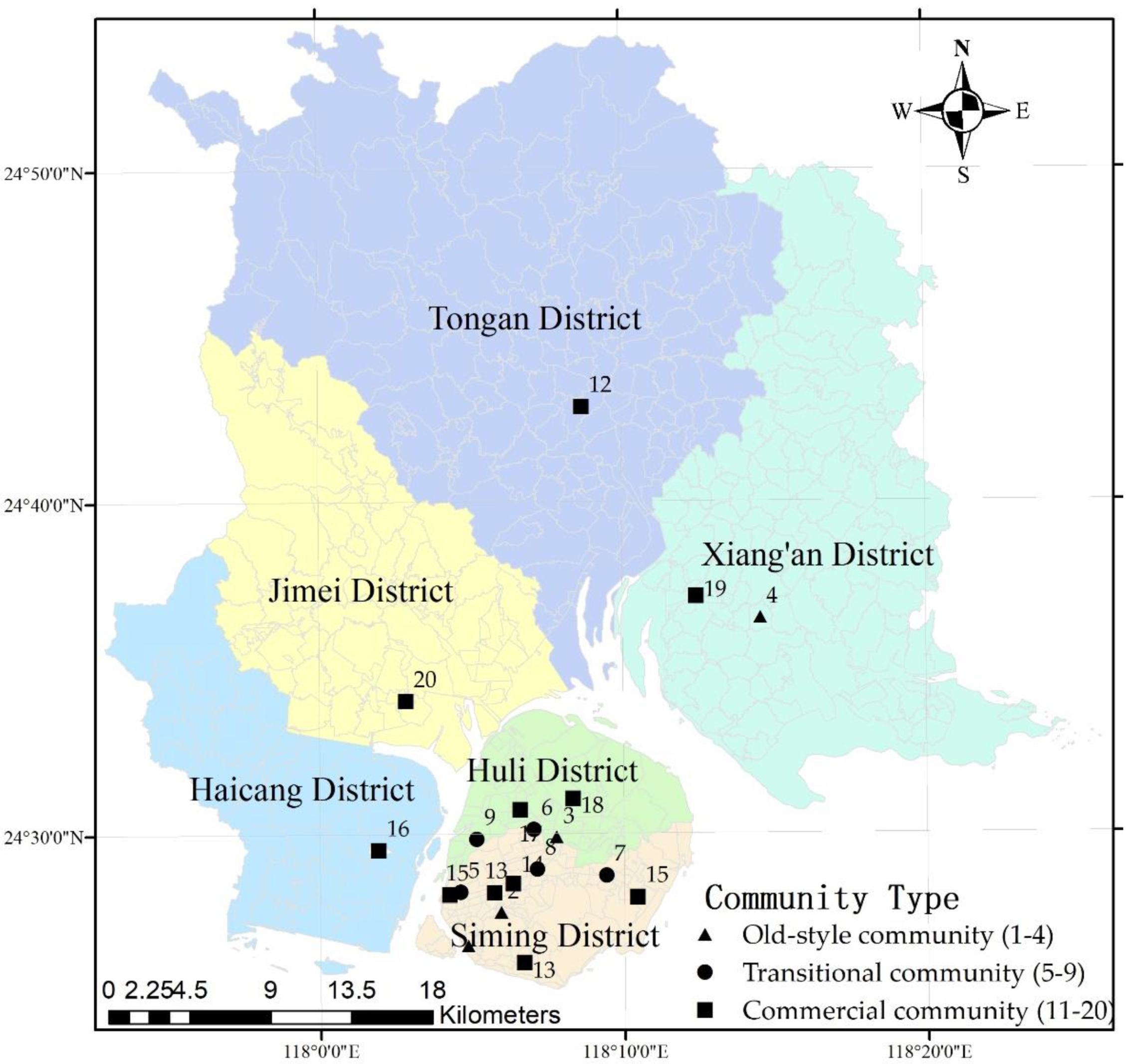
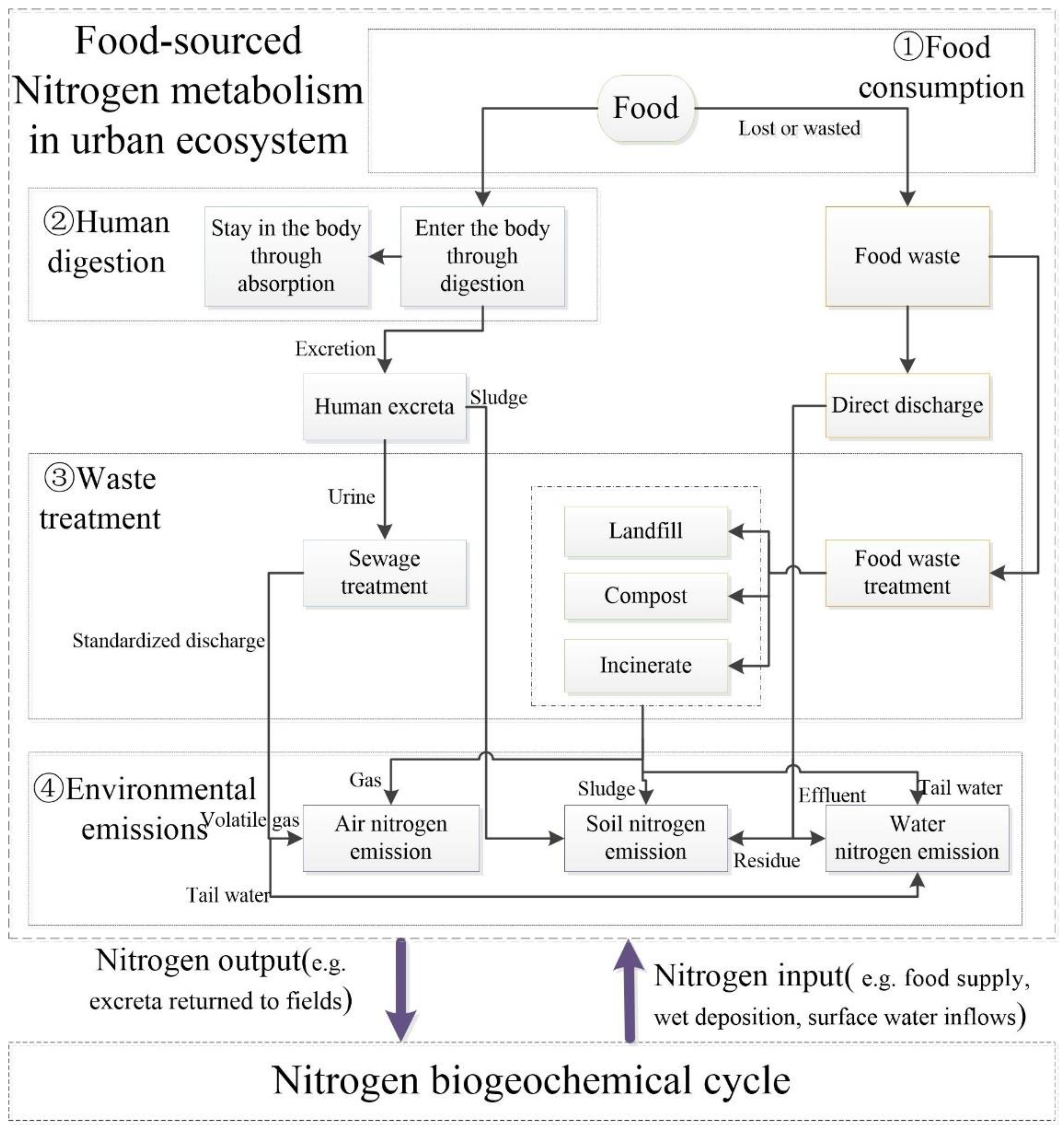
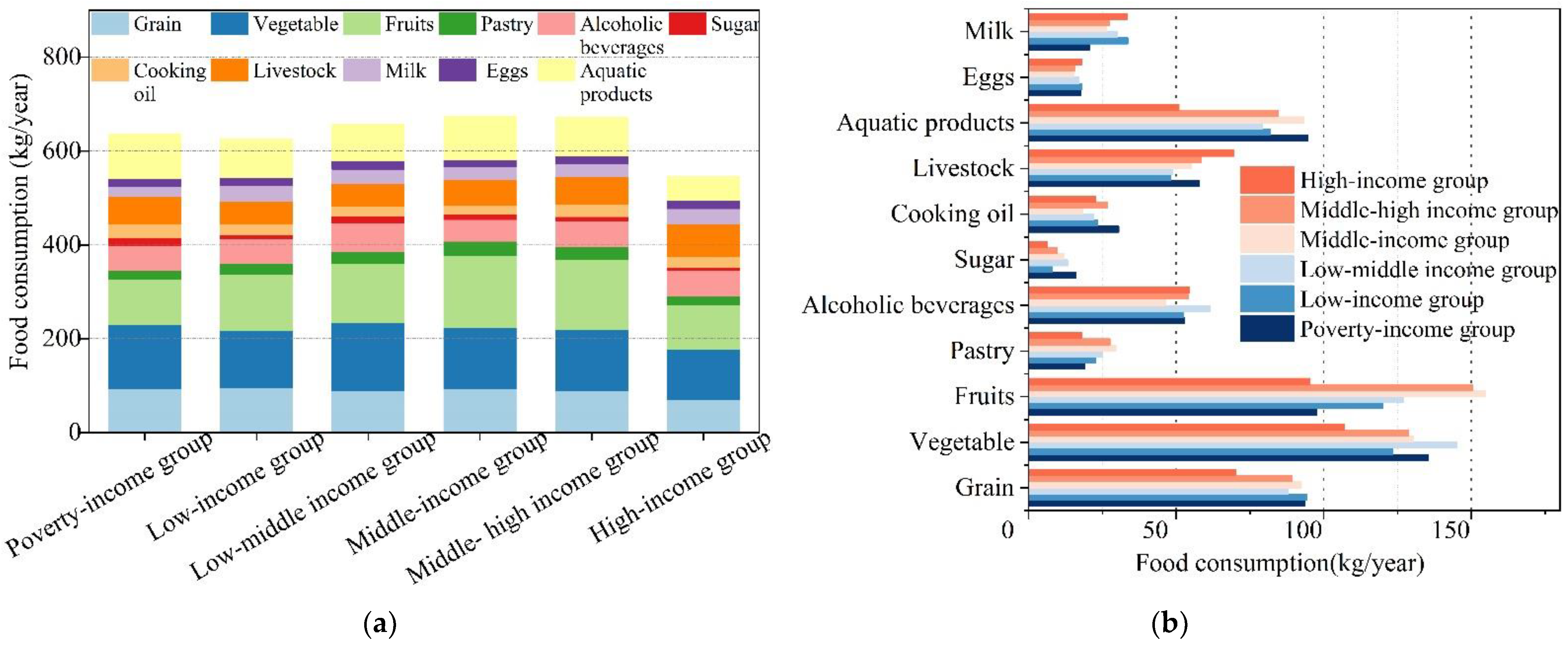
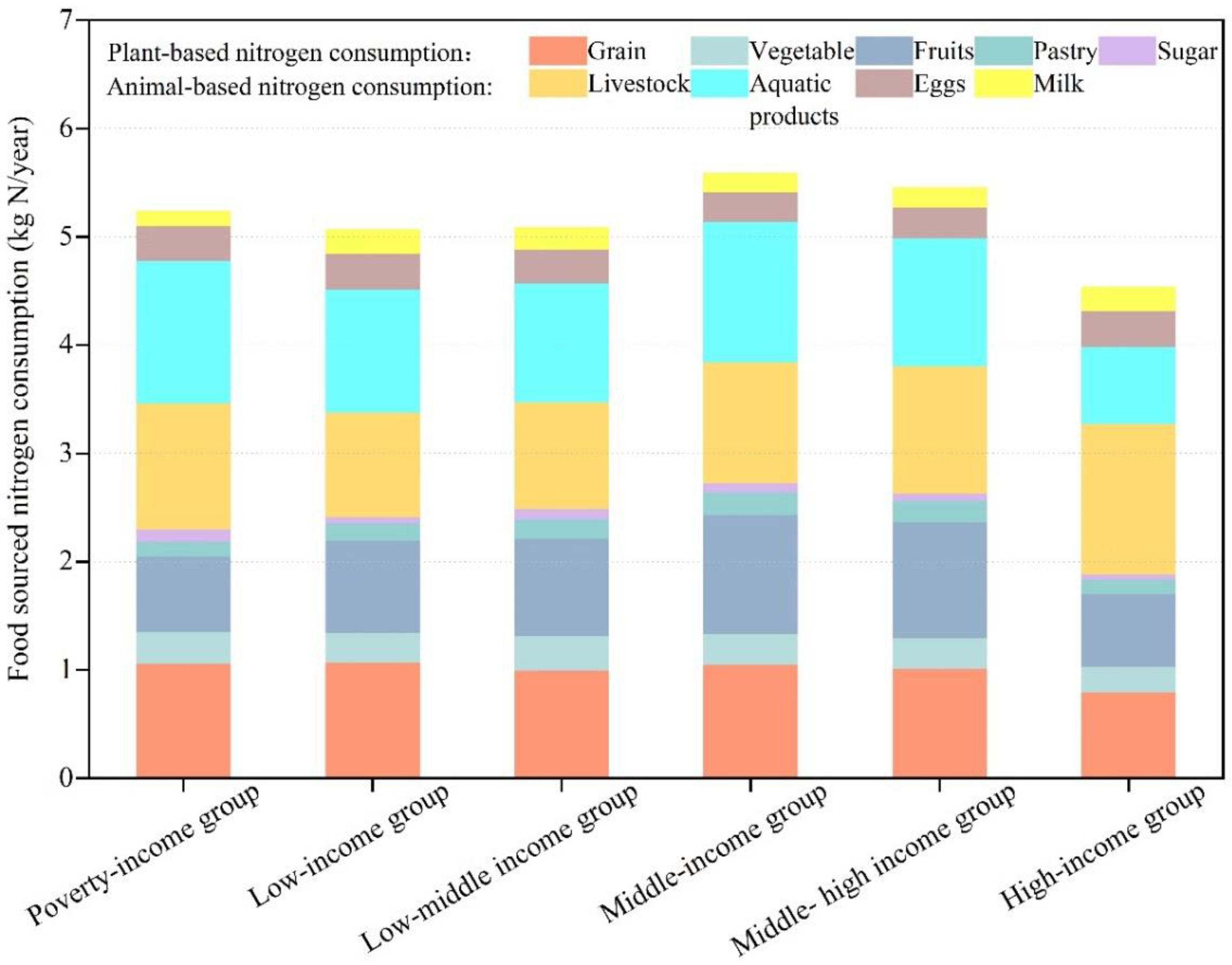
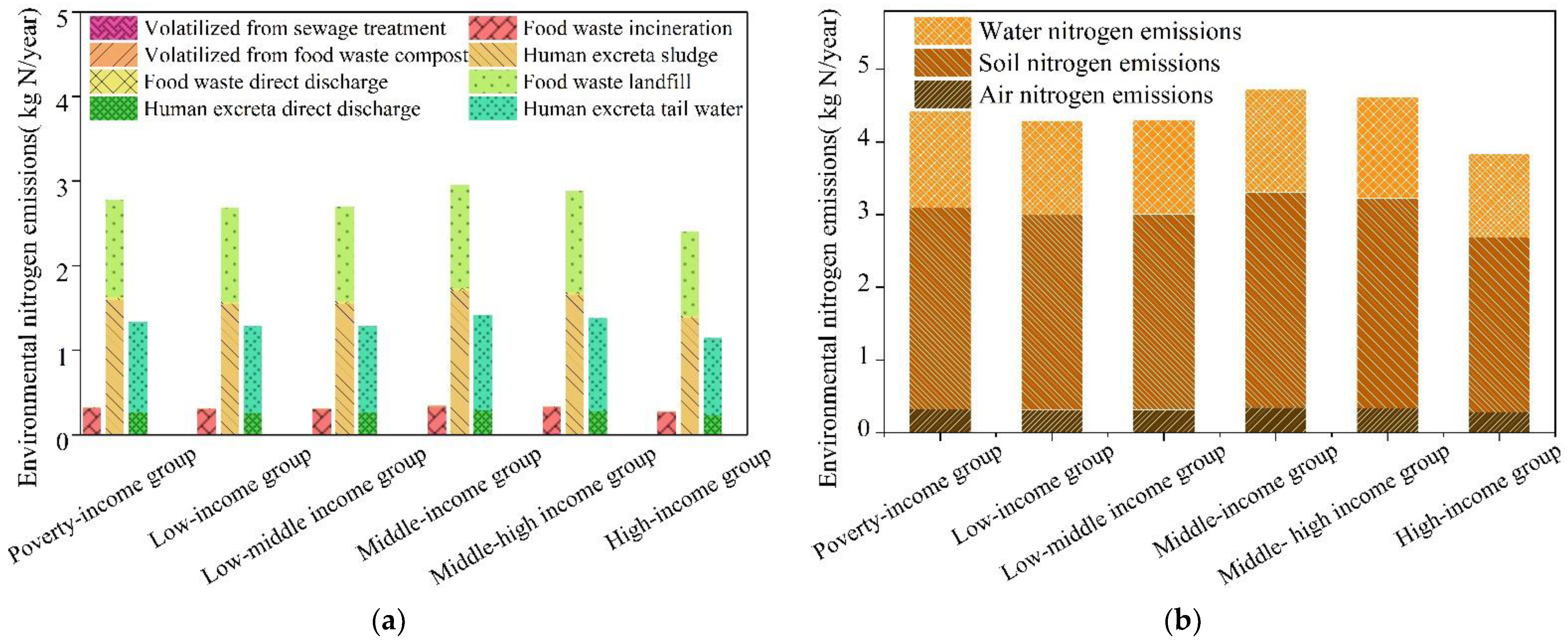
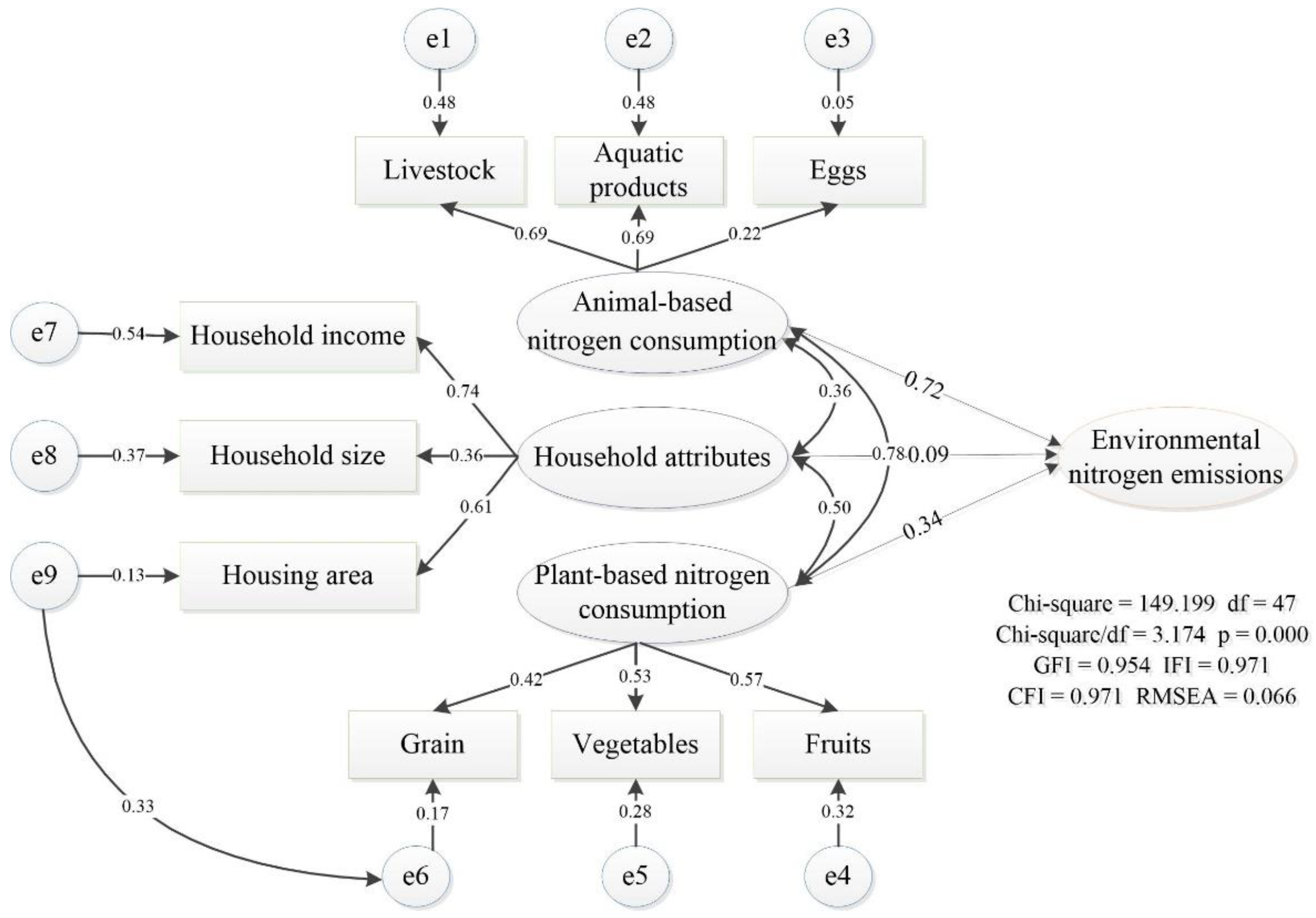
| Latent Variables | Observed Variables |
|---|---|
| Household attributes | Household size, household income, household structure, housing area, building age |
| Household food consumption | Plant-based food: grain (including rice, miscellaneous grains, and flour), vegetables, fruits, edible oils, alcoholic beverages, pastry, sugar, tea; Animal-based food: livestock (pork, beef, sheep, poultry), eggs, aquatic products (fish and seafood), milk |
| Observed Variables | Categories | Transform Standards | Occurrence Frequency (%) |
|---|---|---|---|
| Household size | One person | 1 | 3.59 |
| Two people | 2 | 19.96 | |
| Three people | 3 | 51.10 | |
| Four people | 4 | 15.97 | |
| Five people | 5 | 9.18 | |
| Six people | 6 | 0.20 | |
| Household income (RMB yuan/month) | <2500 (poverty-income) | 1 | 19.16 |
| 2500–5000 (low-income) | 2 | 26.55 | |
| 5000–7500 (low–middle-income) | 3 | 26.95 | |
| 7500–10,000 (middle-income) | 4 | 12.97 | |
| 10,000–20,000 (middle–high-income) | 5 | 12.57 | |
| >20,000 (high-income) | 6 | 1.80 | |
| Household structure | Only the elderly (over 65 years old) | 1 | 4.19 |
| Containing adults and minors (0–17 years old) | 2 | 37.33 | |
| Containing adults and the elderly | 3 | 9.38 | |
| Containing adults, the elderly and minors | 4 | 6.79 | |
| Three adults (18–64 years old) | 5 | 36.13 | |
| Three or more adults | 6 | 6.19 | |
| Housing area | <39 m2 | 1 | 5.19 |
| 40~69 m2 | 2 | 20.56 | |
| 70~89 m2 | 3 | 27.54 | |
| 90~119 m2 | 4 | 29.94 | |
| 120~149 m2 | 5 | 11.58 | |
| >149 m2 | 6 | 5.19 | |
| Building age | Before 1985 (old-style community) | 1 | 23.75 |
| 1985–1989 (old-style community) | 2 | 35.33 | |
| 1990–1994 (transitional community) | 3 | 24.35 | |
| 1995–1999 (transitional community) | 4 | 4.99 | |
| 2000–2005 (commercial community) | 5 | 6.59 | |
| After 2005 (commercial community) | 6 | 4.99 |
| Items | Nitrogen Content/% | Items | Nitrogen Content/% |
|---|---|---|---|
| Grain | 1.13 | Sheep | 2.19 |
| Vegetable | 0.22 | Poultry | 1.89 |
| Fruits | 0.71 | Aquatic products | 1.39 |
| Pastry | 0.71 | Milk | 0.68 |
| Pork | 1.77 | Eggs | 1.83 |
| Beef | 2.20 |
| Item | Indices | Acceptance Criteria | Fitting Result |
|---|---|---|---|
| Absolute fitting indicators | χ2/df | <5 | 3.174 |
| GFI | >0.9 | 0.954 | |
| RMR | <0.08 | 0.060 | |
| RMSEA | <0.08 | 0.066 | |
| Value-added fitting index | NFI | >0.95 | 0.958 |
| CFI | >0.95 | 0.971 | |
| IFI | >0.95 | 0.971 | |
| Simplified fitting index | PGFI | >0.5 | 0.575 |
| PNFI | >0.5 | 0.682 |
Publisher’s Note: MDPI stays neutral with regard to jurisdictional claims in published maps and institutional affiliations. |
© 2021 by the authors. Licensee MDPI, Basel, Switzerland. This article is an open access article distributed under the terms and conditions of the Creative Commons Attribution (CC BY) license (https://creativecommons.org/licenses/by/4.0/).
Share and Cite
Xing, L.; Lin, T.; Xue, X.; Liu, J.; Lin, M.; Zhao, Y. Urban Metabolism of Food-Sourced Nitrogen among Different Income Households: A Case Study Based on Large Sample Survey in Xiamen City, China. Foods 2021, 10, 2842. https://doi.org/10.3390/foods10112842
Xing L, Lin T, Xue X, Liu J, Lin M, Zhao Y. Urban Metabolism of Food-Sourced Nitrogen among Different Income Households: A Case Study Based on Large Sample Survey in Xiamen City, China. Foods. 2021; 10(11):2842. https://doi.org/10.3390/foods10112842
Chicago/Turabian StyleXing, Li, Tao Lin, Xiongzhi Xue, Jiakun Liu, Meixia Lin, and Yu Zhao. 2021. "Urban Metabolism of Food-Sourced Nitrogen among Different Income Households: A Case Study Based on Large Sample Survey in Xiamen City, China" Foods 10, no. 11: 2842. https://doi.org/10.3390/foods10112842
APA StyleXing, L., Lin, T., Xue, X., Liu, J., Lin, M., & Zhao, Y. (2021). Urban Metabolism of Food-Sourced Nitrogen among Different Income Households: A Case Study Based on Large Sample Survey in Xiamen City, China. Foods, 10(11), 2842. https://doi.org/10.3390/foods10112842







